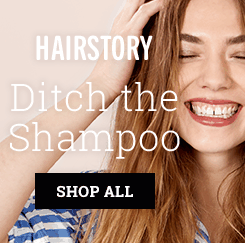As you know by now, understanding your hair type is the first step in maintaining healthy hair. But what comes next?
Whether you’re an experienced natural or someone who’s recently abandoned keratin treatments, hair bleach, perms, or any other damaging agents, you have two primary goals: find products that work for your hair and use them in a way that’s best for your hair.
What Your Hair Needs
Hair products should address two critical needs: moisture and protein. How much moisture and protein your hair needs depends on a few factors.
For one, you must know your hair type and porosity level. One of our recent blog posts was a complete breakdown of hair types. If you missed it, you can read it here. Hair porosity is the other side of the equation.
It simply refers to your hair’s ability to absorb and retain moisture. There are three levels on the porosity spectrum: low, normal and high. Understanding your hair’s porosity level will better help you choose the right products, than if you only knew your hair type.
So, the first step is knowing your hair type, then your hair’s porosity level, and finally finding the right products that works best. Seems simple enough right?
Not so much when there’s tens of thousands of products on the market. It can be overwhelming to decide where to start, and you might just give up before you even begin the hunt for new products.
Trial and Error
This is where we step in to tell you unfortunately it’s not that easy. As a viewer, we don’t see the Youtuber’s trial and error process.
They’ve spent x amount of dollars on x amount of hair products, testing and retesting. They’ve tried products that their hair hated, and products that their hair loved.
What may work for them, may not work for you. Which is why you have to go through your own trial and error process.
The best way to breakdown your hair care routine in order to find products to test is step by step.
Everyone’s wash day routine has a similar structure: shampoo, conditioner, leave-in, and the optional styling product.
Some wash days can get more technical, involving deep conditioning, protein treatments, so on and so forth.
Moisturizing Shampoo vs Clarifying Shampoo
Moisturizing shampoos are recommended for daily/weekly washes. Your best bet is looking for a moisturizing shampoo that does not contain sulfates.
Although sulfates allow dirt and dead skin cells to be removed easily from your skin and hair, they can also strip natural oils from the scalp and hair.
This can make hair dry and brittle. If your scalp is sensitive, sulfates can cause irritation like redness, dryness, and itching.
Shampoos have a tendency to strip hair follicles of its natural moisture. If you do not have too much buildup and wash your hair multiple times a week, shampoo only once.
Conditioners
here are three types of conditioners: rinse-out conditioner, deep conditioner, and leave-in conditioner. All three can be used in tangent with each other or by itself, depending on the wash day.
Rinse-out Conditioner
Rinse-out conditioner is your traditional conditioner that is used after you shampoo your hair. It creates great slip. Slip refers to how lubricious the product makes your hair feel after applying so that you’re able to better detangle your hair.
Often times, we buy a shampoo and conditioner from the same brand within the same line of products. This isn’t always necessary.
Deep Conditioner
Deep conditioners are used as an additional product to moisturize and repair hair follicles. They should be applied thoroughly and left in your hair anywhere from 20 minutes to overnight.
The harder it is for your hair to retain moisture, the more often you should deep condition your hair.
If you hair is prone to producing a lot of natural oils, you would not need to deep condition it as frequently.
Leave-in Conditioner
Leave-in conditioner is an important product for women with Type 3 and 4 hair. Many women with curly and coily hair textures use it as a pre-styling product.
Protein Treatments
Protein treatments should only be incorporated into your wash routine on an as-needed basis. Protein is essential when it comes to hair, nails, and skin. It is used to build tissue cells that help keep your hair healthy and growing.
Serums
The primary purpose of hair serum is to make your locks look shinier, less tangled and healthier. This happens as the serum absorbs and reflects light.
Promt Night

